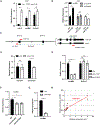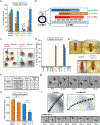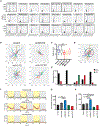circMbl functions in cis and in trans to regulate gene expression and physiology in a tissue-specific fashion
- PMID: 35476987
- PMCID: PMC9352392
- DOI: 10.1016/j.celrep.2022.110740
circMbl functions in cis and in trans to regulate gene expression and physiology in a tissue-specific fashion
Abstract
Muscleblind (mbl) is an essential muscle and neuronal splicing regulator. Mbl hosts multiple circular RNAs (circRNAs), including circMbl, which is conserved from flies to humans. Here, we show that mbl-derived circRNAs are key regulators of MBL by cis- and trans-acting mechanisms. By generating fly lines to specifically modulate the levels of all mbl RNA isoforms, including circMbl, we demonstrate that the two major mbl protein isoforms, MBL-O/P and MBL-C, buffer their own levels by producing different types of circRNA isoforms in the eye and fly brain, respectively. Moreover, we show that circMbl has unique functions in trans, as knockdown of circMbl results in specific morphological and physiological phenotypes. In addition, depletion of MBL-C or circMbl results in opposite behavioral phenotypes, showing that they also regulate each other in trans. Together, our results illuminate key aspects of mbl regulation and uncover cis and trans functions of circMbl in vivo.
Keywords: CP: Molecular biology; Drosophila; MBNL; RNA metabolism; circMbl; circRNA; muscleblind; splicing.
Copyright © 2022 The Authors. Published by Elsevier Inc. All rights reserved.
Conflict of interest statement
Declaration of interests The authors declare no competing interests.
Figures







Similar articles
-
circRNA biogenesis competes with pre-mRNA splicing.Mol Cell. 2014 Oct 2;56(1):55-66. doi: 10.1016/j.molcel.2014.08.019. Epub 2014 Sep 18. Mol Cell. 2014. PMID: 25242144
-
m6A-dependent circular RNA formation mediates tau-induced neurotoxicity.bioRxiv [Preprint]. 2024 Jan 26:2024.01.25.577211. doi: 10.1101/2024.01.25.577211. bioRxiv. 2024. PMID: 38328044 Free PMC article. Preprint.
-
The Muscleblind-like protein MBL-1 regulates microRNA expression in Caenorhabditis elegans through an evolutionarily conserved autoregulatory mechanism.PLoS Genet. 2023 Dec 22;19(12):e1011109. doi: 10.1371/journal.pgen.1011109. eCollection 2023 Dec. PLoS Genet. 2023. PMID: 38134228 Free PMC article.
-
Using Drosophila to uncover molecular and physiological functions of circRNAs.Methods. 2021 Dec;196:74-84. doi: 10.1016/j.ymeth.2021.04.016. Epub 2021 Apr 24. Methods. 2021. PMID: 33901645 Free PMC article. Review.
-
Circular RNAs: the Emerging Class of Non-coding RNAs and Their Potential Role in Human Neurodegenerative Diseases.Mol Neurobiol. 2017 Nov;54(9):7224-7234. doi: 10.1007/s12035-016-0213-8. Epub 2016 Oct 29. Mol Neurobiol. 2017. PMID: 27796758 Review.
Cited by
-
Noncoding RNA Regulation of Hormonal and Metabolic Systems in the Fruit Fly Drosophila.Metabolites. 2023 Jan 19;13(2):152. doi: 10.3390/metabo13020152. Metabolites. 2023. PMID: 36837772 Free PMC article. Review.
-
The therapeutic potential of circular RNA in triple-negative breast cancer.Cancer Drug Resist. 2024 Apr 23;7:13. doi: 10.20517/cdr.2023.141. eCollection 2024. Cancer Drug Resist. 2024. PMID: 38835343 Free PMC article. Review.
-
A brain-enriched circular RNA controls excitatory neurotransmission and restricts sensitivity to aversive stimuli.Sci Adv. 2024 May 24;10(21):eadj8769. doi: 10.1126/sciadv.adj8769. Epub 2024 May 24. Sci Adv. 2024. PMID: 38787942 Free PMC article.
-
Effects of hsa_circ_0074854 on colorectal cancer progression, construction of a circRNA-miRNA-mRNA network, and analysis of immune infiltration.J Cancer Res Clin Oncol. 2023 Nov;149(17):15439-15456. doi: 10.1007/s00432-023-05315-8. Epub 2023 Aug 29. J Cancer Res Clin Oncol. 2023. PMID: 37644235 Free PMC article.
-
Physiological and pathological functions of circular RNAs in the nervous system.Neural Regen Res. 2024 Feb;19(2):342-349. doi: 10.4103/1673-5374.379017. Neural Regen Res. 2024. PMID: 37488888 Free PMC article. Review.
References
-
- Alexa A, and Rahnenfuhrer J (2021). topGO: Enrichment analysis for Gene Ontology. R package version 2.10.0.
-
- Artero R, Prokop A, Paricio N, Begemann G, Pueyo I, Mlodzik M, Perez-Alonso M, and Baylies MK (1998). The muscleblind gene participates in the organization of Z-bands and epidermal attachments of Drosophila muscles and is regulated by Dmef2. Dev. Biol 195, 131–143. 10.1006/dbio.1997.8833. - DOI - PubMed
Publication types
MeSH terms
Substances
Grants and funding
LinkOut - more resources
Full Text Sources
Molecular Biology Databases
Miscellaneous

